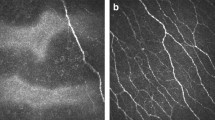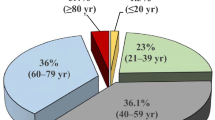Abstract
Purpose
To evaluate anterior ocular surface damage in patients with type 2 diabetes mellitus and dry eye disease in comparison to non-diabetic controls based on conjunctival impression cytology, objective scales (Efron, Oxford) and OSDI, to correlate vision-related quality of life with grades of squamous metaplasia in T2DM patients suffering from DED.
Methods
All participants underwent complete ophthalmologic examination including Shirmer test, TBUT, conjunctival/corneal staining (Oxford scheme), evaluation of conjunctival redness (Efron grading scale), and conjunctival impression cytology (Nelson’s scale). The OSDI questionnaire was completed by both groups of patients to assess severity of DED and QoL.
Results
Squamous metaplasia was observed in 94% of the study group and 19.3% of controls (p = 0.0000). Based on the OSDI scores, 73.5% of patients reported mild DED and 26.5% suffered from moderate DED in the study group. The mean OSDI score for the study group with Nelson’s grade 2 was 18 ± 3.52 and 20.8 ± 4.68 for Nelson’s grade 3, respectively (p = 0.0745). Hence, no significant difference in QoL between grade 2 and grade 3 of squamous metaplasia was observed in patients of the study group.
Conclusion
Impression cytology is a reliable minimally invasive tool for an accurate evaluation of the ocular surface damage in patients with DED and type 2 diabetes mellitus. Severe squamous metaplasia (Nelson’s grade 3) was observed in 29.4% (10/34) of T2DM patients. In contrast, it was not detected in the control group (p = 0.0032). The absence of goblet cells in T2DM patients nether significantly reduces QoL nor contributes to the subjective DED severity (OSDI) due to complex pathways leading to DED. Thus, diagnosis of DED severity should not be solely based on subjective symptoms in this population.

Similar content being viewed by others

Data availability
Data are available from the corresponding author upon reasonable request.
References
Ogurtsova K, Guariguata L, Barengo NC, Ruiz PL, Sacre JW, Karuranga S, Sun H, Boyko EJ, Magliano DJ (2022) IDF diabetes Atlas: Global estimates of undiagnosed diabetes in adults for 2021. Diabetes Res Clin Pract 183:109118. https://doi.org/10.1016/j.diabres.2021.109118
Khan MAB, Hashim MJ, King JK, Govender RD, Mustafa H, Al Kaabi J (2019) Epidemiology of type 2 diabetes - global burden of disease and forecasted trends (2020). J Epidemiol Glob Health 10(1):107–11. https://doi.org/10.2991/jegh.k.191028.001
Han SB, Yang HK, Hyon JY (2019) Influence of diabetes mellitus on anterior segment of the eye. Clin Interv Aging 14:53–63. https://doi.org/10.2147/CIA.S190713
Sayin N, Kara N, Pekel G (2015) Ocular complications of diabetes mellitus. World J Diabetes 6(1):92–108. https://doi.org/10.4239/wjd.v6.i1.92
Zhang X, Zhao L, Deng S, Sun X, Wang N (2016) Dry eye syndrome in patients with diabetes mellitus: prevalence, etiology, and clinical characteristics. J Ophthalmol 2016:8201053. https://doi.org/10.1155/2016/8201053
Fuerst N, Langelier N, Massaro-Giordano M, Pistilli M, Stasi K, Burns C et al (2014) Tear osmolarity and dry eye symptoms in diabetics. Clin Ophthalmol 8:507–515. https://doi.org/10.2147/OPTH.S51514
Haller-Schober EM, Schwantzer G, Berghold A, Fischl M, Theisl A, Horwath-Winter J (2000) Evaluating an impression cytology grading system (IC score) in patients with dry eye syndrome. Eye (Lond) 20(8):927–933. https://doi.org/10.1038/sj.eye.6702058
Puro DG (2020) How goblet cells respond to dry eye: adaptive and pathological roles of voltage-gated calcium channels and P2X(7) purinoceptors. Am J Physiol Cell Physiol 318(6):C1305–C1315. https://doi.org/10.1152/ajpcell.00086.2020
Grubbs JR Jr, Tolleson-Rinehart S, Huynh K, Davis RM (2014) A review of quality of life measures in dry eye questionnaires. Cornea 33(2):215–218. https://doi.org/10.1097/ico.0000000000000038
Schmidl D, Witkowska KJ, Kaya S, Baar C, Faatz H, Nepp J, Unterhuber A, Werkmeister RM, Garhofer G, Schmetterer L (2015) The association between subjective and objective parameters for the assessment of dry-eye syndrome. Invest Ophthalmol Vis Sci 56(3):1467–1472. https://doi.org/10.1167/iovs.14-15814
Calonge M, Diebold Y, Sáez V, Enríquez de Salamanca A, García-Vázquez C, Corrales RM, Herreras JM (2004) Impression cytology of the ocular surface: a review. Exp Eye Res 78(3):457–472. https://doi.org/10.1016/j.exer.2003.09.009
Hagan S (2017) Biomarkers of ocular surface disease using impression cytology. Biomark Med 11(12):1135–1147. https://doi.org/10.2217/bmm-2017-0124
Efron N, Morgan PB, Katsara SS (2001) Validation of grading scales for contact lens complications. Ophthalmic Physiol Opt. 21(1):17–29. https://www.ncbi.nlm.nih.gov/pubmed/11220037
Bron AJ, Evans VE, Smith JA (2003) Grading of corneal and conjunctival staining in the context of other dry eye tests. Cornea 22(7):640–650. https://doi.org/10.1097/00003226-200310000-00008
Singh R, Joseph A, Umapathy T, Tint NL, Dua HS (2005) Impression cytology of the ocular surface. Br J Ophthalmol 89(12):1655–1659. https://doi.org/10.1136/bjo.2005.073916
Zhmud TM, Drozhzhyna GI, Demchuk AV (2021) Journal of ophthalmology (Ukraine)cytological features of the bulbar conjunctiva in patients with type 2 diabetes 1. J ophthalmology 498:24–31. https://doi.org/10.31288/oftalmolzh202112431
Kesarwani D, Rizvi SWA, Khan AA, Amitava AK, Vasenwala SM, Siddiqui Z (2017) Tear film and ocular surface dysfunction in diabetes mellitus in an Indian population. Indian J Ophthalmol 65(4):301–304. https://doi.org/10.4103/ijo.IJO_939_15
Bhargava R, Kumar P, Kaur A, Kumar M, Mishra A (2014) The diagnostic value and accuracy of conjunctival impression cytology, dry eye symptomatology, and routine tear function tests in computer users. J Lab Physicians 6(2):102–108. https://doi.org/10.4103/0974-2727.141507
Acknowledgements
We thank Dr. S. Suchok for the assistance with statistical analysis and language editing that greatly improved the manuscript.
Author information
Authors and Affiliations
Contributions
All authors contributed to the study conception and design. Material preparation, data collection, and analysis were performed by TMZ, GID, and NVM. The first draft of the manuscript was written by TMZ and all authors commented on previous versions of the manuscript. All authors read and approved the final manuscript.
Corresponding author
Ethics declarations
Ethics approval and consent to participate
All procedures performed in studies involving human participants were in accordance with the ethical standards of the institutional and/or national research committee and with the 1964 Helsinki Declaration and its later amendments or comparable ethical standards. The study was approved by the Bioethics Committee of the National Pirogov Memorial Medical University, Vinnytsya, Ukraine. Informed consent was obtained from all individual participants included in the study.
Consent for publication
Written informed consent for publication of the case (including imaging) was obtained from all participants.
Competing interests
The authors declare no competing interests.
Additional information
Publisher's note
Springer Nature remains neutral with regard to jurisdictional claims in published maps and institutional affiliations.
This article received support from the mentorship team. Further information can be found in the editorial https://link.springer.com/article/10.1007/s00417-019-04518-5.
Rights and permissions
Springer Nature or its licensor holds exclusive rights to this article under a publishing agreement with the author(s) or other rightsholder(s); author self-archiving of the accepted manuscript version of this article is solely governed by the terms of such publishing agreement and applicable law.
About this article
Cite this article
Zhmud, T., Drozhzhyna, G. & Malachkova, N. Evaluation and comparison of subjective and objective anterior ocular surface damage in patients with type 2 diabetes mellitus and dry eye disease. Graefes Arch Clin Exp Ophthalmol 261, 447–452 (2023). https://doi.org/10.1007/s00417-022-05806-3
Received:
Revised:
Accepted:
Published:
Issue Date:
DOI: https://doi.org/10.1007/s00417-022-05806-3



